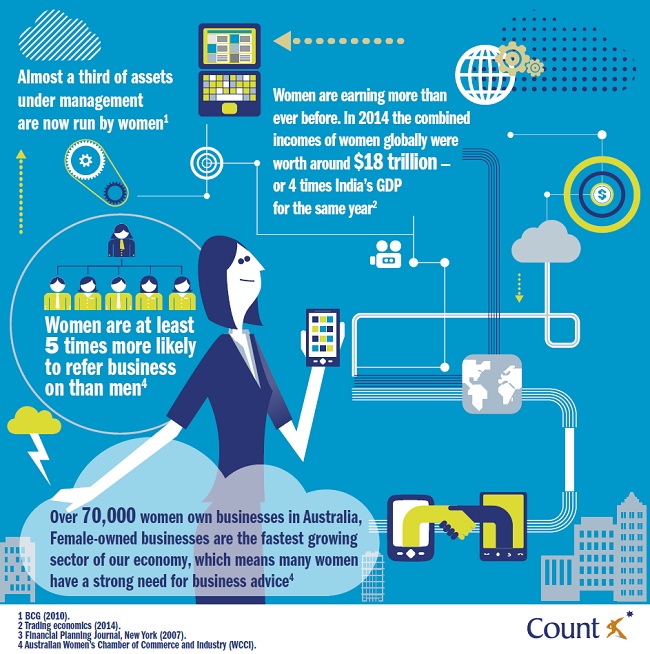For accounting firms looking to offer advisory services to clients, it’s important to understand and recognise the vital role that financial advice can play in women's lives.
Things you should know: Count used reasonable efforts to ensure the commentary in this blog was accurate and true at the time that it was posted, but Count is not liable for any errors or omissions in the commentary. Since the time of posting it is possible that regulatory requirements and laws upon which the commentary were based have changed and the content is outdated. The commentary provided in this blog is informational only and while care was taken in the preparation of this blog, no liability is accepted by Count, its related entities, agents and employees for any loss arising from reliance on this blog. Any commentary regarding past economic performance is no indication of future performance and should be used as a general guide only.
According to Meaghan Noble, CBA Executive Manager - Women and Advice, understanding women’s needs is also good for business. It can help you better engage with your client base — and grow your business too.

Women are becoming wealthier
Women are earning more than ever before. In 2014 for example, the combined incomes of women globally were worth around $18 trillion — or four times India’s GDP for the same year.1
Here in Australia, almost a third of assets under management are now run by women.2 And although they’re still paid less than men, more women are moving into senior management roles, increasing their earning capacity.3 Women live longer than men as well, which is one of the reasons they’re more likely to receive an inheritance during their lifetime.4
Meaghan Noble also points out that growing numbers of women are choosing to start their own business.
“Over 70,000 women own businesses in Australia,” she explained. “Female-owned businesses are the fastest growing sector of our economy,5 which means many women have a strong need for business advice.”
Women need their money to work harder
While women are building wealth at an increasing rate, they also face unique financial obstacles.
[View our conversation aid Women and Advice: Bridging the Super Gap]
“Although social norms are evolving, women still undertake the majority of childcare and unpaid work,” Noble said. “They’re also more likely to take more time off during their working lives to care for elderly parents.”
Lower wages and interrupted working patterns mean women tend to accumulate less super than men. As investors, women can also be more risk averse.
“Women across all age groups are less likely than men to take on additional risk to achieve higher returns,” Noble explained. “But of course, this could set them up for another risk — running out of retirement savings.”
These challenges are exacerbated by the fact that women need their super to stretch further. Not only do they tend to live longer than men, they’re also more likely to retire earlier with a smaller nest egg.
How can you help?
Here are three ways your firm can reach out and connect with more women — and better meet the needs of your existing female clients.
1. Recognise, research and revise
Start by applying a gender lens over every aspect of your business and client value proposition.
“It’s a good idea to review all your current practices, from your first contact with potential clients to your ongoing service model — and everything in between,” Noble said. “You don’t have to reinvent the wheel; it’s more about avoiding any unconscious gender bias, like assuming the male in a couple is always the decision-maker.”
For instance, in meetings with client couples you should always direct questions to each partner and ensure your advice addresses the needs and goals of them both.
2. Create an action plan
Women’s propensity to refer more than men presents many opportunities for growing your business. So make sure you make the most of it.
“Think of ways to leverage existing practices, case studies and marketing material so you can engage women over the course of the year,” Noble suggested.
One way is to regularly share female-focused articles in your client newsletters or through LinkedIn, Facebook or your website. Another option is to run events like financial literacy seminars, and invite your female clients to each bring a friend.
“It’s a good idea to add an annual social event to your calendar specifically for women, which will also encourage networking,” said Noble.
3. Check your communication style
Research shows that women tend to look at the whole picture when they’re receiving new information, whereas men are more selective about what they process. This is worth keeping in mind whenever you talk to clients.
“In general, women prefer a more personal and collaborative style of communication,” Noble commented. “Female clients will appreciate the opportunity to ask questions and give their input into the advice process.”
“And when you’re providing advice to women, make sure you clearly link the advice to the positive impact it have on their financial needs and lifestyle.”
1 India GDP per capita, Trading economics, 2014.
Why Women are the Biggest Emerging Market, Harvard Business Review, 2010.
2 Leveling The Playing Field, BCG, 2010.
3 Australian Social Trends, Australian Bureau of Statistics, Dec 2012.
4 2015 Intergenerational Report Australia in 2055, Treasurer of the Commonwealth of Australia, March 2015.
5 Australian Women’s Chamber of Commerce and Industry (WCCI).